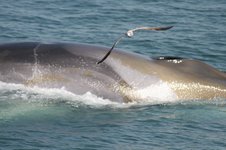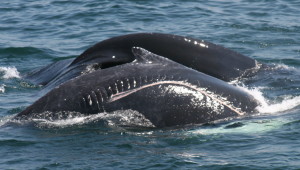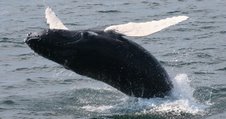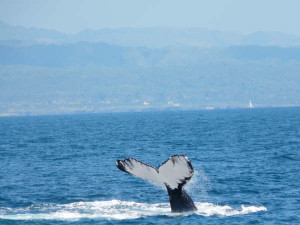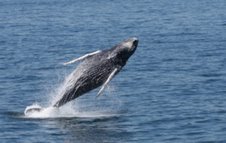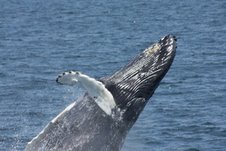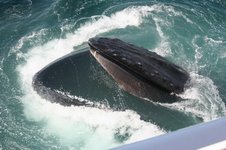Dolphin Fleet Naturalist Notebook 14 June to 20 June
On June 14 we began the morning by heading east at Race Point Light and skirting the world-renowned parabolic dunes of Provincetown. It was among these dunes that artists including Harry Kemp and Eugene O’Neill were inspired by the virtually untouched landscape and the glistening expanse of the Atlantic Ocean. From the vantage point of these dunes, it is sometimes possible to see several types of whale species feeding along the upwelling created by the steep drop-off from the beach. Fin whales in particular seem to dominate the corridor between Race Point and Peaked Hill, and today, passengers aboard the Dolphin VIII were fortunate to see them feeding.
Fin whales, sometimes reaching lengths exceeding 80 feet, have a very sleek and streamlined shape, and are able to move in bursts of speed of up to 20 miles an hour! Today, they were using their speed to lunge through schools of prey, and with each mouthful their enormous bodies lifted slightly as their mouths filled with fish. In the photo below, notice the silver swirling pattern on the right side of each animal which characterizes each individual fin whale. This pattern is known as the blaze and chevron.
On June 15 we returned to the same area east of Race Point and were immediately awed by the sight of Pinstripe’s calf breaching. Pinstripe was first documented in 1997 and this is her first known calf. Pinstripe’s calf will stay with its mother for about a year as it builds up its body weight by feeding on its mother’s milk. It is not always easy to catch a nursing event, but we were able to deduce what was going on as the calf swam back and forth underneath its mother, coming up for air on either side of Pinstripe’s body.
June 16 was overcast, but our visibility remained almost unlimited as we were able to see Manomet Point, just south of Plymouth Harbor from all the way across the bay. Mother and calf humpback pairs were plentiful, and throughout the day we saw Whisk, Scylla, Nuages, and Vulture, all with their associated calves.
Whisk was born in 1987. She is here with her third calf.
Nuages and her calf are particulary easy to identify, for unfortunate reasons. Nuages calf has a large propeller scar down the right side of its body. This is especially sad as this calf is less than 6 months old. Nuages herself has not been immune to encounters with boats, as her dorsal fin also shows signs of damage from a ship strike.
Nuages and calf
On the morning of June 17 we were joined by Provincetown Elementary School, here to get a closer look at the ecosystem that is literally in their backyard.
Upon leaving shore, we soon encountered Ventisca and her calf. Ventisca is easily identified by the hazy white pigmentation on her large dorsal fin. She was first observed in 2001, and until recently, her gender was unknown. This is her first known calf.
Ventisca and calf
Throughout the day, Ventisca and her calf made numerous appearances. On the 1:30 trip on the Dolphinn VIII, this little calf jumped right out of the water–a breach!
June 18th marked the return of one of our favorite humpbacks–a male named Coral. Coral has been returning to Stellwagen Bank nearly every summer since his birth in 1988. This past winter, Peter Sanchez, one of our interns from last summer, sent word that Coral had been spotted in Samana Bay, which is part of the Dominican Republic. Peter reports, “Coral was sighted on 14 March 2008, Samana Bay, Dominican Republic at the following coordinates: longitude 69.1707 degrees W and latitude 19.1405 degrees N. It was seen alone, but very active, flipper flopping, lobtailing, and breaching.”
Coral in the Dominican Republic
Currently, our interns from last summer are working on a project in the Dominican Republic to expand their knowledge of the individual humpbacks that visit the area during the winter to calve. They are working closely with scientists who study these same animals in the North Atlantic during the summer feeding season.
Navajo, another humpback observed during the past week, was also seen near the Turks and Caicos, also in the Caribbean on March 20th.
On June 19th we started the day on a high note. There were so many breaching humpback whales it was hard to know where to look. First, Division’s calf gave us a clue by diving very quickly in what we call a “wind up”. These speedy dives are often precursers to breaches. Sure enough, like clockwork, Division’s calf. burst forth from the water!
As if this wasn’t spectacular enough, we were soon lured to the northwest by the sight of three more humpbacks breaching simultaneously! Though two of the whales, Tectonic and Tulip stopped after one breach, Photon continued to breach until it was time to go home. No one knows exactly what causes these whales to breach, but one passenger brought up the fact that maybe it had something to do with impending full moon!
Photon
The next day, on June 20th, the Dolphin VI had a relatively unusual sighting for mid-summer as one of our boats encountered the critically-endangered North Atlantic Right Whale. In the winter months, these massive animals congregate in Cape Cod Bay to feed on the copious amounts of copepods, which are orange-tinged crustaceans about the size of a grain of rice. This past winter over 150 unique right whales were identified in Cape Cod Bay from January through May. That represents over one-third of the entire population!
At this time of year, it is more likely to spot these animals in the Great South Channel before they head up to the Bay of Fundy. However, these animals can be unpredictable. This one in particular startled us as it popped up within several hundred feet of the vessel. It is against federal law to approach a right whale within 500 yards, so upon seeing this animal, we stopped the boat until the animal had safely traveled away, at which point we headed in the opposite direction!
Fortunately, there were many more animals throughout the day with which we could spend more time. In the morning, there was a great deal of humpback feeding. Schools of sand lance were clearly visible at the surface and our humpbacks frequently came up through these schools with their mouths wide-open.
As the wind picked up in the afternoon and the humpbacks finished their meals, many of these animals began breaching. As we moved from one whale to the next we could see many more giant white splashes on the horizon. We ended the day with a humpback named Buckshot and her calf. Buckshot was lobtailing, or repeatedly slapping the water with her tail. Meanwhile, her calf breached intermittantly nearby. Perhaps we witnessed a communication between this mother and calf, but we will need further studies to determine what these behaviors mean.
Buckshot lobtails






